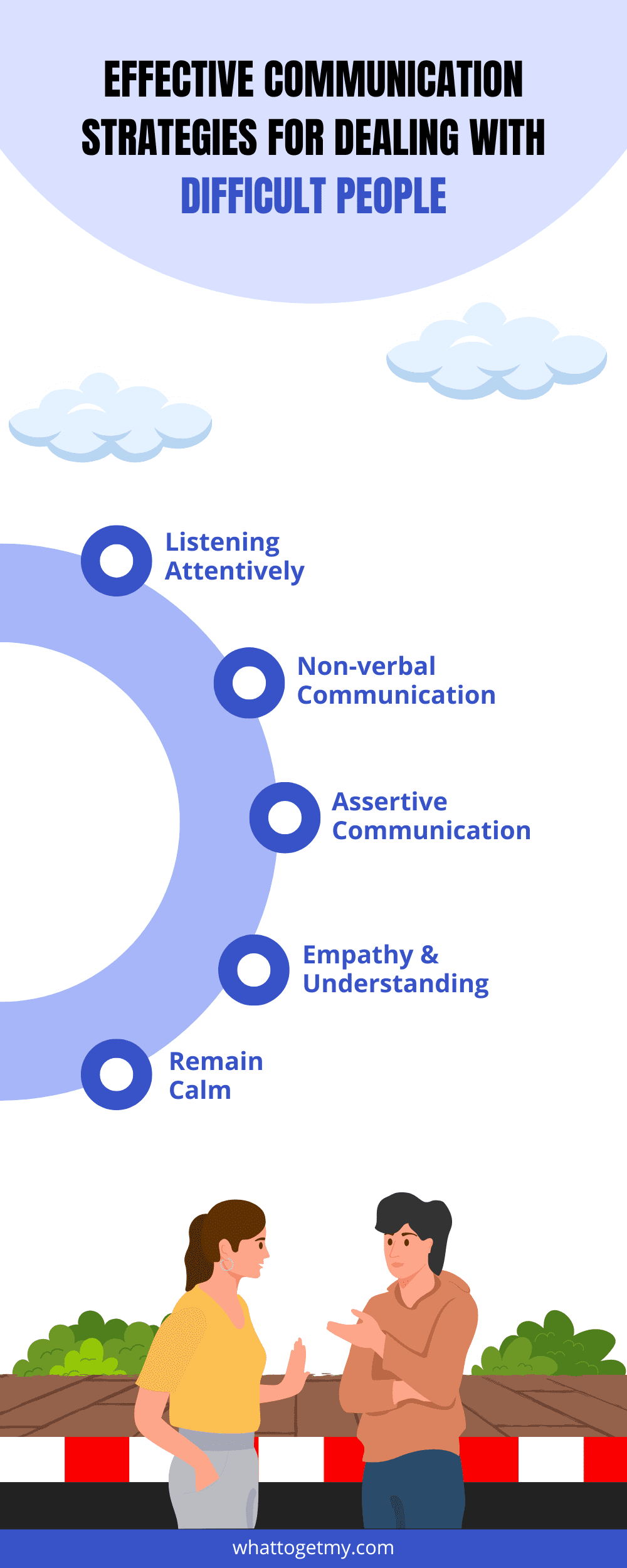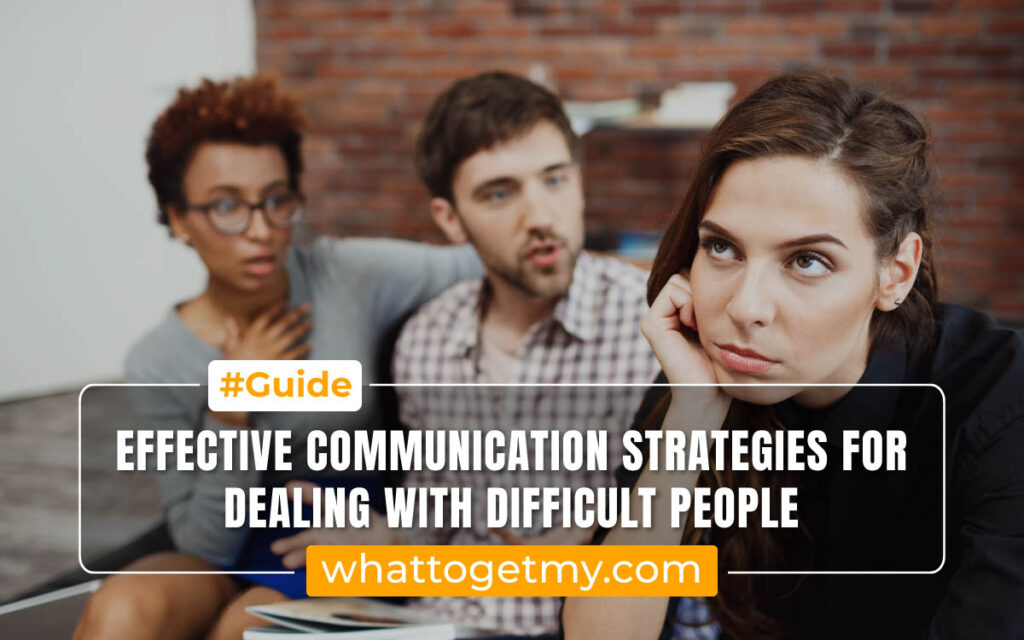Best 9 Effective Communication Strategies for Dealing with Difficult People: A Guide (2023)
-
Dealing with difficult people is a common challenge in various aspects of life, whether it’s in the workplace, personal relationships, or social interactions.
-
Furthermore, to communicate effectively with complex individuals, seek to understand their perspectives by asking clarifying questions and paraphrasing their statements.
-
Assertive communication also involves being direct and specific in your communication.
-
Empathy and understanding are essential qualities when dealing with complex individuals.
Paying attention to your non-verbal signals and being aware of others’ cues can help you better understand their emotions and intentions.
Dealing with difficult people is a common challenge in various aspects of life, whether it’s in the workplace, personal relationships, or social interactions. However, by employing effective communication techniques, we can navigate these situations with more confidence and success. In this article, we will explore a range of effective communication strategies for dealing with difficult people.
I. Understanding Difficult People
Before delving into the strategies for dealing with difficult individuals, gaining a deeper understanding of what makes people difficult is essential. DiComplexndividuals may exhibit traits such as aggression, defensiveness, stubbornness, and a lack of empathy. We can approach them with empathy and tailor our communication strategies accordingly.
II. Effective Communication Techniques
1. Active Listening:
Active listening is a foundational skill for effective communication. It involves giving your full attention to the person speaking, demonstrating genuine interest, and seeking to understand their perspective. By actively listening, you can foster a sense of trust and create an environment where complex individuals feel heard and validated.
Active listening is one of the vital communication skills for handling challenging people. It is a component of effective communication. It goes beyond simply hearing someone’s words; it involves actively engaging with the speaker and showing genuine interest in their thoughts and feelings. Active listening is crucial in establishing rapport and understanding when dealing with difficult individuals.
To practice active listening, give your full attention to the person speaking. Maintain eye contact, nod or provide verbal cues to indicate your engagement, and refrain from interrupting. By showing that you are fully present in the conversation, you create a safe space for the problematic individual to express themselves.
Furthermore, to communicate effectively with complex individuals, seek to understand their perspectives by asking clarifying questions and paraphrasing their statements. This demonstrates that you are genuinely interested in their thoughts and feelings. Avoid making assumptions or jumping to conclusions, which can hinder effective communication.
Active listening also involves observing non-verbal cues such as body language and tone of voice. These cues can provide valuable insights into the speaker’s emotions and help you better understand their perspective. By paying attention to both verbal and non-verbal cues, you can gain a more comprehensive understanding of the difficult individual’s message.
Active listening is a powerful tool for navigating conversations with complex individuals. You can build trust, foster effective communication, and constructively resolve conflicts by actively engaging with the speaker, demonstrating genuine interest, and seeking to understand their perspectives.
2. Assertive Communication
Assertive communication involves expressing your thoughts, feelings, and needs clearly and respectfully. As one of the techniques for effective communication with challenging people, it allows you to communicate your boundaries while maintaining respect for the other person. Being assertive allows you to establish mutual understanding and reduce the likelihood of escalating conflicts.
Regarding tips for dealing with difficult personalities through communication, assertive communication is a valuable skill. It involves expressing yourself confidently and respectfully, effectively conveying your thoughts, feelings, and needs. Being assertive allows you to set clear boundaries, express your perspective, and establish mutual understanding.
Using “I” statements to express your thoughts and feelings is essential when practicing assertive communication. This approach focuses on personal experiences and avoids blaming or criticizing the other person. For example, instead of saying, “You always make things difficult,” you can say, “I feel frustrated when things become challenging.”
Assertive communication also involves being direct and specific in your communication. Clearly state what you want or need from the other person, using clear and concise language. This helps to avoid misunderstandings and promotes effective communication.
Additionally, maintaining a calm and composed demeanor is essential in assertive communication. It’s important to control your emotions and avoid becoming aggressive or passive. Stay respectful and non-confrontational while expressing yourself assertively.
By practicing assertive communication, you can establish a healthy and respectful dialogue with complex individuals. It allows you to express your boundaries and needs while respecting the other person. Assertive communication promotes positive and effective communication by fostering mutual understanding and reducing the likelihood of conflicts escalating.
3. Non-Verbal Communication
Non-verbal cues, such as body language, facial expressions, and tone of voice, play a significant role in communication. Paying attention to your non-verbal signals and being aware of others’ cues can help you better understand their emotions and intentions. By aligning your non-verbal communication with your verbal message, you can enhance the effectiveness of your interactions.
Among the effective communication strategies for managing difficult people, non-verbal communication is a powerful aspect of human interaction. It encompasses various cues, such as body language, facial expressions, gestures, and tone of voice, that convey messages without using words. Understanding and effectively utilizing non-verbal communication can significantly enhance the clarity and impact of your interactions, especially when dealing with complex individuals.
It is crucial to be aware of your non-verbal signals. Pay attention to your body posture, facial expressions, and tone of voice. Ensure that your non-verbal cues align with your message. For example, maintaining open and relaxed body language, making eye contact, and using a calm and respectful tone of voice can foster a positive and receptive atmosphere.
Secondly, observing others’ non-verbal cues is equally essential; by attentively observing their body language, facial expressions, and tone of voice, you can gain valuable insights into their emotions, intentions, and attitudes. This understanding allows you to respond appropriately and adapt your communication style to facilitate better understanding and connection.
Non-verbal communication can also help you establish rapport and build trust with complex individuals. By mirroring their body language and expressions to a certain extent, you can create a sense of empathy and connection. However, it’s essential to do this authentically and respectfully without crossing personal boundaries.
In addition, non-verbal cues can help clarify and reinforce your verbal message. For instance, using hand gestures to emphasize key points, maintaining eye contact to show attentiveness, and nodding to indicate understanding can enhance the impact of your words and ensure effective communication.
Overall, non-verbal communication is a powerful tool among communication methods for handling challenging individuals. By paying attention to your non-verbal signals, being aware of others’ cues, and aligning your non-verbal communication with your verbal message, you can enhance the effectiveness of your interactions, foster better understanding, and build stronger connections.
According to Statista, based on a 2022 study conducted among internet users in the United States, phone calls were utilized by nearly all of the participants, with 95 percent indicating their usage of this form of communication in both professional and personal contexts. Text messages, SMS, and messaging platforms were equally prevalent as emails among U.S. users, with 92 percent of respondents confirming their engagement with these communication channels during the surveyed timeframe.
4. Empathy and Understanding
Difficult people often have underlying reasons for their behavior. By practicing empathy and understanding, you can see the situation from their perspective and identify potential triggers or concerns. Showing empathy can create a more compassionate and open space for dialogue, leading to improved communication and conflict resolution.
Empathy and understanding are essential qualities when dealing with complex individuals. Rather than immediately judging or reacting to their behavior, taking the time to understand their perspective can provide valuable insights into their actions and motivations. By practicing empathy, you acknowledge that there might be underlying reasons for their problematic behavior.
Empathy involves putting yourself in the other person’s shoes and grasping their emotions, experiences, and challenges. It requires active listening, attentiveness to verbal and non-verbal cues, and genuine concern for their well-being. Demonstrating empathy creates a safe and non-judgmental space for them to express themselves and share their concerns.
Understanding is closely linked to empathy. It involves recognizing that complex individuals may have unique circumstances, past experiences, or personal struggles contributing to their behavior. By seeking to understand their perspective, you can identify potential triggers or underlying issues that fuel their demanding demeanor.
Setting aside your biases and preconceptions is essential when practicing empathy and understanding. Approach the situation with an open mind and a willingness to see beyond surface-level behaviors. This mindset allows you to view the individual as a whole, with their fears, insecurities, and challenges.
You can establish trust and respect in your interactions with complex individuals by demonstrating empathy and understanding. It helps create an environment where they feel heard, validated, and understood. This, in turn, paves the way for more constructive and effective communication, conflict resolution, and potential personal growth for both parties involved.
Remember, empathy and understanding do not mean condoning or accepting harmful behavior. It means acknowledging the complexity of human emotions and experiences and approaching complex individuals with compassion and openness. Practicing empathy can foster healthier and more productive relationships, even with the most challenging individuals.

III. Strategies for Dealing with Difficult Individuals
1. Remain Calm and Composed
When faced with a problematic individual, it’s crucial to maintain your composure and avoid reacting impulsively. Responding with anger or defensiveness can escalate the situation further. Take a deep breath, gather your thoughts, and respond composedly.
Remaining calm and composed is crucial for effectively dealing with complex individuals. When faced with challenging situations or confrontations, it’s natural to feel a surge of emotions, such as anger, frustration, or defensiveness. However, reacting impulsively can often exacerbate the problem and hinder productive communication.
Maintaining your composure allows you to approach the situation clearly and rationally. It helps you think more objectively and make informed decisions about responding. By staying calm, you are better equipped to listen actively, understand the other person’s perspective, and find mutually agreeable solutions.
One effective technique to remain calm is to take a deep breath. Deep breathing activates the body’s relaxation response, helping to reduce stress and restore a sense of calm. It allows you to pause momentarily, collect your thoughts, and gain control over your emotions before engaging in a conversation or addressing the issue.
Another critical aspect of remaining calm is awareness of your triggers and emotional hot buttons. Understanding what pushes your buttons can help you proactively manage your reactions and prevent unnecessary escalation of conflicts. Practice self-awareness and self-regulation, recognizing when your emotions are intensifying and taking steps to de-escalate them.
Additionally, maintaining composure involves actively choosing your words and tone of voice. Aim to express yourself assertively and respectfully, avoiding inflammatory or confrontational language. Focus on the issue rather than personal attacks, and strive for a collaborative and solution-oriented approach.
It’s important to remember that remaining calm and composed does not mean suppressing your emotions or disregarding your feelings. It means finding a balance between acknowledging and validating your emotions while still maintaining control over your reactions.
By staying calm and composed in the face of problematic individuals, you demonstrate emotional maturity, assertiveness, and a commitment to resolving conflicts constructively. This approach helps de-escalate the situation and fosters respect and open communication, increasing the likelihood of finding common ground and achieving positive outcomes.
2. Choose the Right Time and Place
Regarding strategies for effective communication with difficult people,
timing and environment play a significant role in effective communication. Choose a suitable time and place for discussions, ensuring privacy and minimal distractions. By creating a conducive setting, you can foster focused and productive conversations.
Choosing the right time and place for communication is essential when dealing with difficult situations or individuals. The timing and environment can significantly impact a conversation’s outcome and your communication’s effectiveness.
Selecting a suitable time means finding a moment when both parties are relatively calm and receptive to conversation. Avoid addressing sensitive or challenging topics when stressed, preoccupied, or in a rush. Instead, choose a time when you both have the mental and emotional capacity to listen and participate in the discussion actively.
Equally important is selecting an appropriate setting. Find a location where you can have privacy and minimal distractions, allowing for open and uninterrupted communication. Consider a neutral space where both individuals feel comfortable and express themselves freely without feeling threatened or judged.
Sometimes, scheduling a specific time for the conversation may be beneficial rather than approaching it spontaneously. Allowing both parties to prepare mentally and emotionally increases the chances of having a constructive dialogue.
When choosing the right time and place, it’s also essential to consider the other person’s schedule and preferences. Find a time that works for both of you and consider any external factors that might influence the environment, such as noise or other distractions.
Selecting an appropriate time and place sets the stage for a focused and productive conversation. It allows both individuals to feel comfortable, safe, and respected, which promotes open communication and the opportunity to address complex topics more effectively. Remember, effective communication is not just about what is being said but also the context in which it occurs.
3. Use “I” Statements
Here is another one from the bucket of communication tips for navigating difficult personalities: when expressing your concerns or addressing conflicts, use “I” statements to convey your feelings and experiences without blaming or accusing the other person. For example, instead of saying, “You always make me feel ignored,” you can say, “I feel ignored when our conversations get interrupted frequently.”
Using “I” statements is an effective communication technique when dealing with difficult situations or conflicts. It involves expressing your thoughts, feelings, and concerns using statements that focus on your perspective rather than placing blame or accusing the other person.
By using “I” statements, you take ownership of your emotions and experiences, which can help create a less aggressive and more constructive dialogue. It allows you to express yourself assertively without putting the other person on the defensive.
4. Find Common Ground
Seek areas of agreement and common interests to establish a foundation of rapport. Finding common ground can help create a sense of connection and facilitate a more constructive dialogue. Look for shared goals or values that can serve as a starting point for building understanding.
Finding common ground is essential for effective communication, especially when dealing with complex individuals. By seeking areas of agreement and shared interests, you can establish a foundation of rapport and create a sense of connection.
Finding common ground helps to build a bridge between you and the other person, allowing for a more constructive and open dialogue. It provides a starting point for understanding and can help to minimize conflicts or differences.
One way to find common ground is by identifying shared goals or objectives. Look for areas where both parties have a similar desired outcome or a common purpose. By focusing on these shared aspirations, you can shift the conversation towards finding solutions and working together towards a common goal.
Exploring common interests or values can also foster a sense of connection and understanding. Look for hobbies, beliefs, or experiences that you both share. Engaging in conversations about these shared interests helps establish rapport and create a positive atmosphere for communication.
When seeking common ground, it’s essential to approach the conversation with an open mind and a willingness to listen. Be curious and genuinely interested in the other person’s perspective. By demonstrating your willingness to find areas of agreement, you encourage the other person to do the same.
Finding common ground does not mean compromising your values or beliefs. It is about finding points of convergence that can serve as a starting point for building understanding and resolving conflicts. It allows you to create a more collaborative and cooperative environment where both parties can work together towards a mutually beneficial outcome.
Finding common ground is a valuable strategy for effective communication with complex individuals. By seeking areas of agreement, shared goals, or common interests, you can establish a foundation of rapport and create a more constructive dialogue. This approach encourages understanding, promotes collaboration, and increases the likelihood of finding mutually beneficial solutions.
5. Set Boundaries
Maintaining healthy boundaries is essential when dealing with complex individuals. Communicate your limits and expectations, and be firm in enforcing them. Setting boundaries demonstrates self-respect and signals to the other person what behavior is acceptable.
Setting boundaries is a crucial aspect of dealing with complex individuals. It involves establishing and communicating your limits, expectations, and needs clearly and assertively. By setting boundaries, you create a framework that promotes respect, protects your well-being, and defines acceptable behavior in your interactions.
Communicating your limits to the problematic individual is essential when setting boundaries. Be specific about what you will and will not tolerate, and express your expectations regarding their behavior. Use assertive communication techniques to convey your boundaries in a respectful yet firm manner.
Enforcing boundaries is equally important. Consistently uphold your boundaries and be prepared to act appropriately if they are crossed. This may involve addressing the behavior directly, disengaging from the interaction, or establishing consequences for repeated boundary violations.
Setting boundaries demonstrates self-respect and sends a clear message to the problematic individual about what is acceptable behavior in your relationship. It helps to create a healthy and balanced dynamic where both parties understand and respect each other’s boundaries.
Remember, setting boundaries is not about being selfish or unkind. It is about prioritizing your well-being and maintaining your emotional and mental health. Establishing clear boundaries empowers you to navigate difficult situations with greater confidence and self-assurance.
Setting boundaries is essential to dealing with complex individuals. You establish a framework that promotes respect and protects your well-being by clearly communicating your limits, expectations, and needs and enforcing those boundaries. Setting boundaries is an act of self-care and self-respect, allowing you to maintain healthier and more balanced relationships.
Frequently Asked Questions
Q1: How can I maintain my composure when dealing with difficult people?
A1: Maintaining composure when dealing with difficult people can be challenging but essential. One effective strategy is to take deep breaths and practice self-awareness to stay grounded. Remember to stay focused on the issue and not get caught up in emotional reactions. Developing a support system of friends or colleagues who can provide guidance or a listening ear can also be helpful during challenging interactions. Engaging in stress-relieving activities such as meditation, exercise, or journaling can also contribute to keeping calm and composed in difficult situations.
Q2: What can I do if the difficult person refuses to change their behavior?
A2: It is important to remember that we cannot control other people’s behavior. If the problematic person refuses to change, adjust your expectations and focus on managing your reactions. This can involve setting clear boundaries to protect yourself, minimizing contact or interactions with the person when possible, and seeking support from others who understand the situation. It may also be beneficial to explore self-care and stress management strategies to help cope with the ongoing challenges posed by the difficult person.
Q3: How can I improve my communication skills to handle difficult people better?
A3: Improving communication skills is crucial for effectively dealing with difficult people. One helpful technique is active listening, which involves giving your full attention, showing empathy, and seeking to understand the other person’s perspective. Additionally, assertive communication can help express your thoughts and feelings clearly and confidently while maintaining respect. Developing emotional intelligence, which includes recognizing and managing your own emotions as well as understanding the emotions of others, can also enhance your communication abilities. Consider seeking resources such as books, workshops, or online courses focusing on effective communication strategies to enhance your skills further.
IV. Conclusion
Ultimately, this highlights that effective communication strategies are invaluable tools for dealing with difficult people. You can navigate challenging interactions more successfully by practicing active listening, assertive communication, empathy, and understanding. Remember to remain calm, choose the right time and place for discussions, and use “I” statements to express your thoughts and feelings. By implementing these strategies, you can foster healthier relationships, resolve conflicts more effectively, and create a more harmonious environment when interacting with complex individuals.
Incorporating these effective communication techniques and strategies for dealing with complex individuals will empower you to overcome communication barriers, establish mutual understanding, and enhance the quality of your relationships. By honing your communication skills, you can confidently navigate challenging situations and build more productive connections with those around you.
01 HOURS 46 MINUTES
ESTIMATED TIME DESIGNING AND UPLOADING THIS ARTICLE
08 HOURS 45 MINUTES
ESTIMATED TIME RESEARCHING AND WRITING THIS ARTICLE
LOOKING FOR MORE GIFTS?
Try our AMAZING GIFT FINDER TOOL! Find GIFTS with 1 CLICK!
LOOKING FOR MORE GIFTS?
Try our AMAZING GIFT FINDER TOOL! Find GIFTS with 1 CLICK!
LOOKING FOR MORE GIFTS?
Try our AMAZING GIFT FINDER TOOL! Find GIFTS with 1 CLICK!
You Might Also Like



